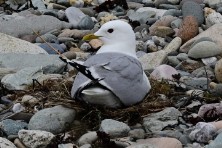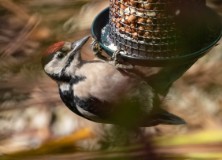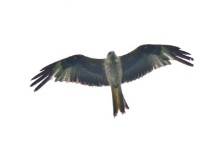June 2022
Bird Sightings



June was cool and wet. Although the mean-temperature was almost identical to last June, the highest temperature was three degrees lower and there was more than double the rain of last June. While the first week was predominantly dry with the highest temperature for the month, after that it was unsettled.
The unsettled weather seems to have been helpful to some of our ground nesting birds. With less use of beaches and shores by humans, there was less disturbance and more reports of young Oystercatcher, Ringed Plover and Common Gull.
The unsettled weather did not deter many birds raising young during the long daylight hours in June. Some observers reported gardens full of young birds. There were many reports of fledged birds in gardens including unfamiliar looking young birds, like Goldfinch without the red face of the adult birds, and Robin with spots and no red breast. Among the familiar garden birds Blackbird, Song Thrush, Chaffinch, Blue Tit, Great Tit and Dunnock seemed to be doing well. Most prolific of all seemed to be House Sparrow, with thirty in Alma Park on 25th being one of the larger numbers. Also, there were many reports of numbers of Siskin and Goldfinch with young around, including forty Siskin in Whiting Bay on 12th and thirty Goldfinch in Lagg on 17th . In addition, Bullfinch seemed to have had a particularly good breeding season with widespread reports including twelve with young from Cordon on 10th. Again, it was encouraging to get reports of young Greenfinch and young Great Spotted Woodpecker from widespread locations. In Corrie, unusually, an adult Common Sandpiper was reported ushering young through a garden towards the shore on 25th.
Away from gardens there were many signs of breeding including, roding Woodcock in Machrie on 6th, a pair of Mute Swan with six young at Carlo on 7th, Mallard with seven young in the Cloy River on 9th , Skylark singing over Machrie Moor on 22nd, nesting Little Grebe and Moorhen at Mossend Pond on 30th and activity at the Grey Heron heronries in Stronach Wood, Brodick, Lagg and Whitehouse Wood, Lamlash by the end of the month. The Sand Martin colony in Glen Catacol had one hundred and two nest holes and was a hive of activity on 4th. To date the largest group of Swallow was twelve at Corrie on 6th while the largest group reported of House Martin was eighteen at Whiting Bay on 12th . There was a feeling that the unsettled weather had delayed the breeding of these summer visitors. On the other hand, Cuckoo, whose decreasing numbers are a cause for concern nationally, seems to be thriving on Arran.
The breeding success of some raptors is linked to the vole cycle. Bumper years of voles tend to be followed by a crash followed by a gradual build up followed by a bumper year in a roughly four-year cycle. Last year was a crash year with few voles around. This year the vole population is on the increase and those licensed to monitor Barn Owl and Short-eared Owl territories report a better breeding season than last year.
In June a number of scarce summer visitors were reported but none lingered, a male Merlin at Bennecarrigan on 2nd, a Quail in Sliddery also on 2nd, a Lesser Whitethroat at Catacol on 4th, a Common Redstart at Moss Farm on 6th and a Corncrake in Machrie on 21st
Other highlights in a month with around one hundred species reported included the following: two Arctic Tern at Kildonan on 1st, a Red Kite at Corriecravie on 7th, two Golden Plover in Catacol Bay on 8th, three Dunlin at Blackwaterfoot on 11th, three pair of feeding Red-throated Diver in Whiting Bay on 12th and three Swift over Clachaig on 20th.
Finally in July, look out for early signs of breeding being over for some birds this year. These could include the return of some Arctic breeding species to our shores, as they travel south. Remember July is the time when many birds, having raised their young, go about the process of renewing their feathers by moulting them. As birds are vulnerable when they are shedding flight feathers, they literally make themselves scarce. On any birding walk you may see fewer birds, but they are still around.


